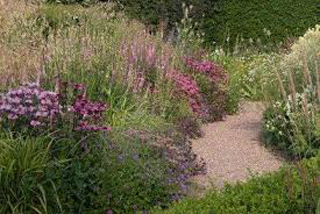
This extended dry spell has got us all thinking about watering: how much, when, how to prevent evaporation, and all the usual subjects. We will touch on that, and other considerations in a moment, but if, as seem to becoming accepted wisdom, summers are going to be heating up in future, let’s take a step back and think about planting accordingly.
There are many plants and categories of plant which could be termed drought-tolerant or drought-resistant. And not coincidentally, many them are suitable for a coastal environment because they have evolved to be tough. Something to keep in your mind when you are thinking about what will tolerate your conditions is where a plant occurs naturally, provided we give it good drainage to allow for our wetter winters. If it lives in hot dry climes, then there is a good chance it will work here too.
A cautionary note applying to everything we mention below though. They are drought-tolerant once they are established. To become established, plants will need to be watered and settled in, so there is no escaping watering new plantings, regardless of what they are.
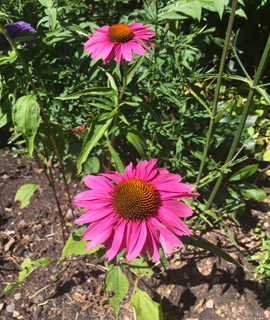 First of all, because they are quite trendy, (thanks, Piet Oudolf) a good category of plant to consider are the “prairie plants”. These are the plants of the open prairies of North and South America, and South African grasslands, and Australasia. Dry and exposed environments, these plants are by and large herbaceous perennials (ie disappearing underground in winter) although some retain some above ground presence in our climate.
First of all, because they are quite trendy, (thanks, Piet Oudolf) a good category of plant to consider are the “prairie plants”. These are the plants of the open prairies of North and South America, and South African grasslands, and Australasia. Dry and exposed environments, these plants are by and large herbaceous perennials (ie disappearing underground in winter) although some retain some above ground presence in our climate.
Good examples of the prairie plant category are gaura (very on trend this year), often known as Whirling Butterflies because of their waving stems and light and airy appearance, achillea, agapanthus, crocosmia, solidago, sedum (or xylotelephium as we must call some of them now), stachys (lamb’s ears), and verbena in its various forms. Many take on the daisy shape often seen among prairie flowers – anthemis, rudbeckia, leucanthemum, heliopsis, gaillardia, helenium, echinacea in all its wide range of colours now and of course, asters. There are many others too; something for every taste and colour pallet. We saw a garden in Brittany last year planted just with gaura, and it did look effective. Not our chosen style of planting, but striking nonetheless.
Inextricably linked to the flowering prairie plants are the family of grasses and sedges. Again, you have a very wide range of choice – within each species, you can find a range of heights, leaf colours and feathery flower types. Look for miscanthus, luzula, calamagrostis, carex, stipa, festuca and pennisetum – but bear in mind that the pennisetum group is not always reliably hardy, even here in Cornwall. Wet rather than cold will see it off. The good thing about grasses is that they will generally be visible throughout winter, giving a herbaceous area a bit of structure, and a ghostly, ethereal feel.
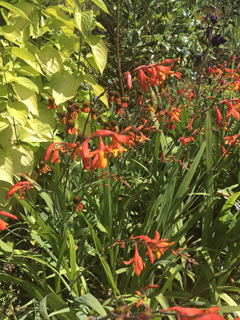 At this point, we will also say “pampas grass” in the sprit of inclusion, but that’s all we’re saying on that subject…..
At this point, we will also say “pampas grass” in the sprit of inclusion, but that’s all we’re saying on that subject…..
Grasses can be a pricey investment, but start with small plants or plugs and bring them on in pots for a season or so, and you will be rewarded for your efforts.
If you give the prairie plants a home, they will prove largely untroubling guests provided you give them good drainage and full sun. You will be call upon to divide them every 3 years or so (spring not autumn) to keep the clump flowering well, but besides that, they are easy to grow.
If it’s shrubs you want, think silver, grey and sage green leaves, and you probably won’t go far wrong. Think hebes, cistus, olearia, potentilla, buddleja, eucalyptus, ficus (figs) convolvulus (not bindweed!!), phlomis, olives, rosemary, lavender, shrubby echiums, shrubby thymes, callistemon (bottle brush), brachyglottis (was senecio), some euphorbias, culinary sage, but also the huge range of ornamental sages (salvias as they tend to be known) which come in almost every colour of the rainbow these days. Various palm –like plants – cordylines, trachycarpus, Canary palms, phormiums and evil yuccas will also do well, although we realise that not everyone likes that spiky shape and prefers a softer look to their planting.
And the final group which likes it drier are the alpine/rockery plants, which are acclimatised to tough conditions, and succulents, which have evolved to store their own water source. There are 101 funky varieties of the latter and they can look quite striking if allowed to creep and tumble around rustic, even broken, pots. Go to your local garden centre and have a poke around at all the shapes and styles available, and we guarantee there will be at least one you like. They prefer to come in out of the winter wet, and will survive just as well as a house/conservatory plant.
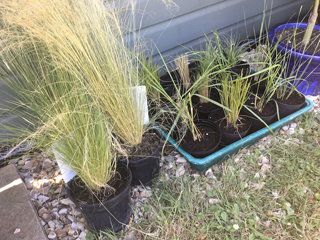 This is not an exhaustive list by any stretch, but rather than fighting our new normal, we must learn to live with it, and you never know, you might grow to like these plants.
This is not an exhaustive list by any stretch, but rather than fighting our new normal, we must learn to live with it, and you never know, you might grow to like these plants.
What should we be doing against this weather backdrop if the water butts are empty?
We have had to resort to the hosepipe even for established beds on occasion. We don’t like doing it, but sometimes needs must. Be sparing, and rather than using a spray setting on the hose (half of that evaporates) use a more targeted flow and direct it around the base of your most precious plants.
Remember also that pots dry out more quickly so you are going to have to check them more often. Terracotta and ceramic behave like a small bread oven and hold their heat far longer than you might imagine. And more frequent watering means nutrient in the compost will be used up and washed through more quickly so feed regularly too.
In the case both plants in the garden and pots, you can help retain water around their base by watering well, then putting a thick layer of mulch down. Bark, well-rotted manure, old compost, a layer of leaves, even gravel and pebbles will all help to keep the precious water in the soil and stop it evaporating.
We believe the most effective time to water is very first thing in the morning – so set the alarm a little earlier and wander round with the hosepipe or can in one hand, and a cup of tea in the other. Watering at this time gives the chance for plants to take up the water before it evaporates. You could water in the evening, but common lore is that this encourages slugs to emerge and nibble at your cherished veg and flowers, and encourages mildew.
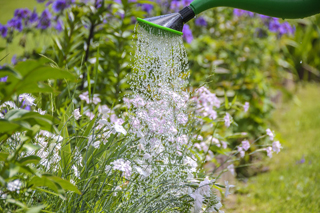 One thing to be sure of though is the difference between a plant that is thirsty, and needs a good soak, and a plant whose soft growth has simply wilted in the heat of the day, and will pick up again as soon as the temperature drops. Check the soil around your plant, and the weight of any pots if you are able to pick them up.
One thing to be sure of though is the difference between a plant that is thirsty, and needs a good soak, and a plant whose soft growth has simply wilted in the heat of the day, and will pick up again as soon as the temperature drops. Check the soil around your plant, and the weight of any pots if you are able to pick them up.
If the compost or soil seems damp an inch or so down, the plant probably doesn’t need watering yet. Overwatering can cause other problems such as leggy and even softer growth, which is vulnerable to aphid attack or simply saturated roots, which can easily moulder in this heat. If a plant is still floppy first thing in the morning, then a watering is needed for sure.
Finally, a big thank you to everyone who supported us and our colleagues Emma and Jo in our skydive on 11 July, in aid of Cancer Research. Take a look at Pengelly Garden Centre’s Facebook page for the evidence!! If you are passing the garden centre, please do feel free to pop and support our efforts by putting a little loose change in our collection buckets or by buying a cut flowers or other produce for our fundraising. It will make our lunacy all worthwhile.
And we’ll see what hare-brained idea Jo comes up with next year, to keep us all young and scared.
Keep cool in the meantime.
Sarah Daniel and Helen Robins
Pengelly Garden Centre
www.pengellygardencentre.co.uk
